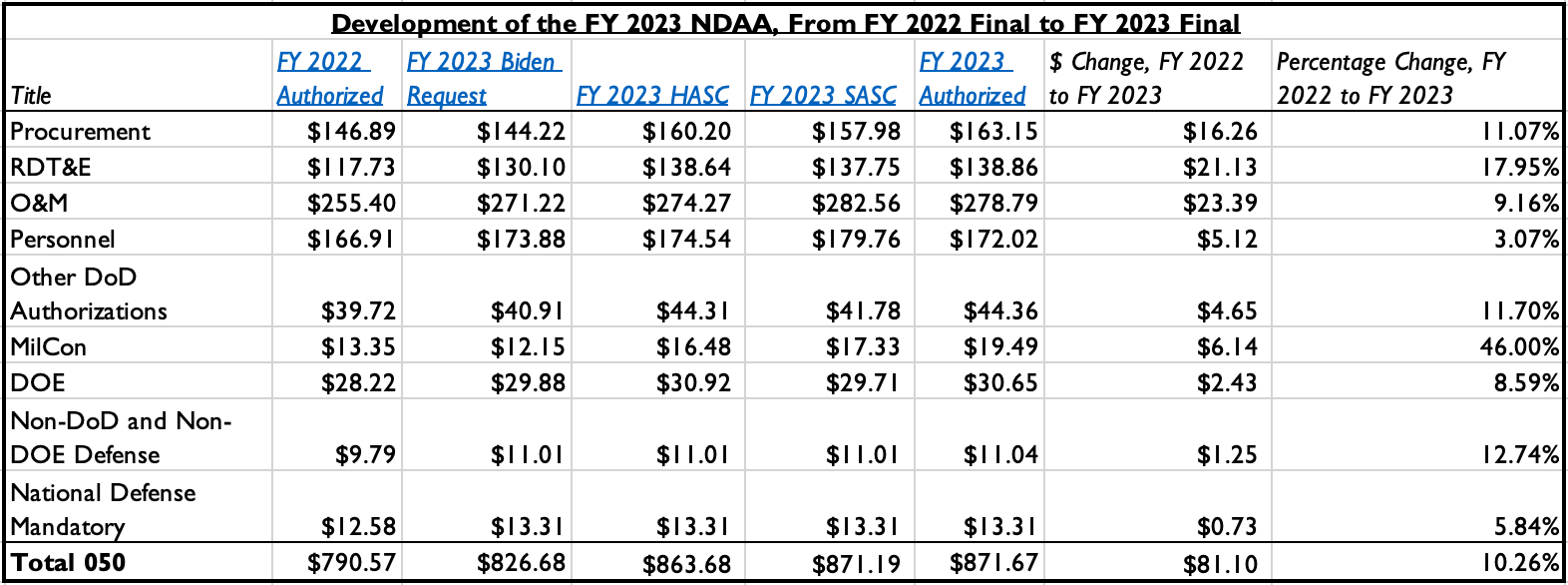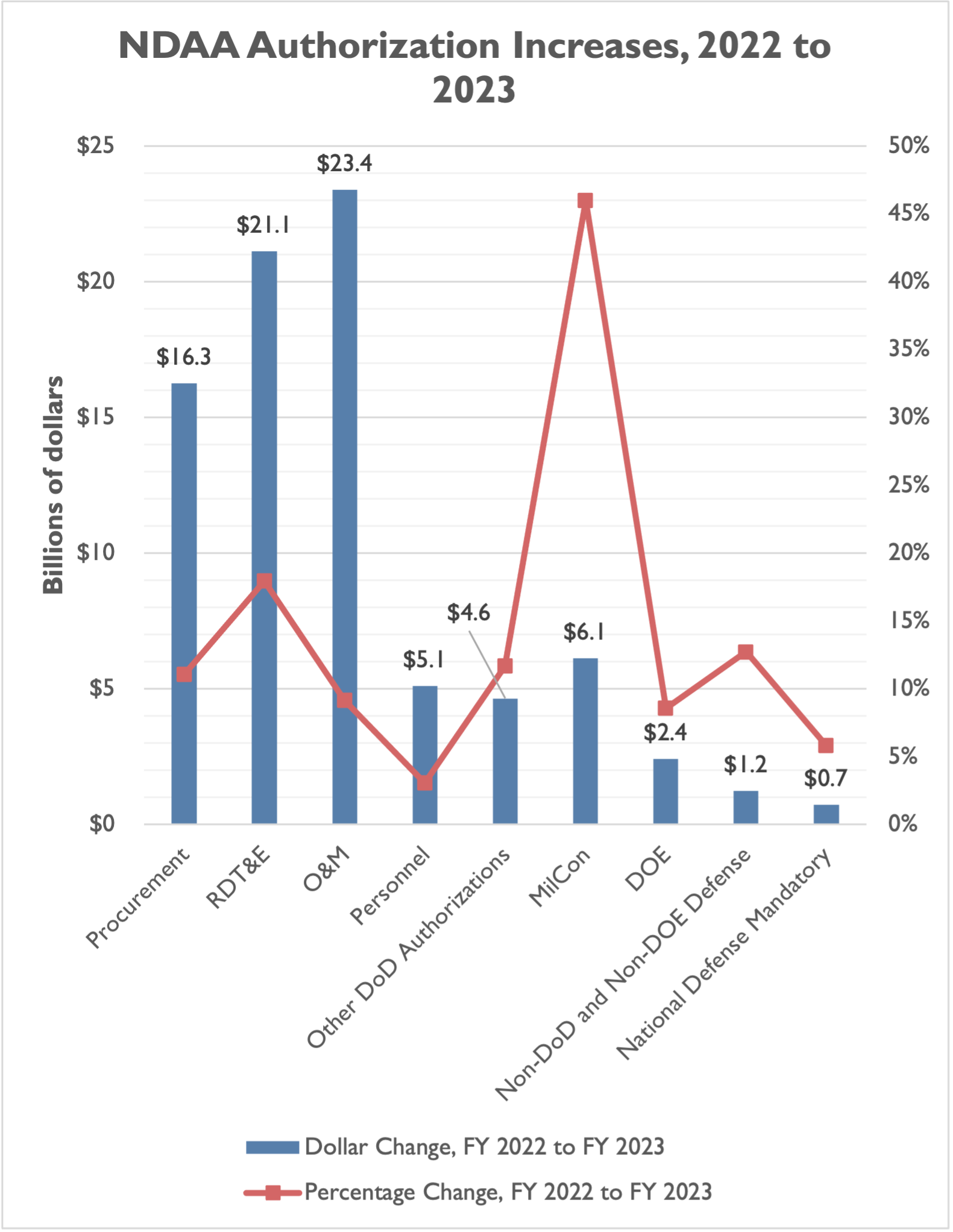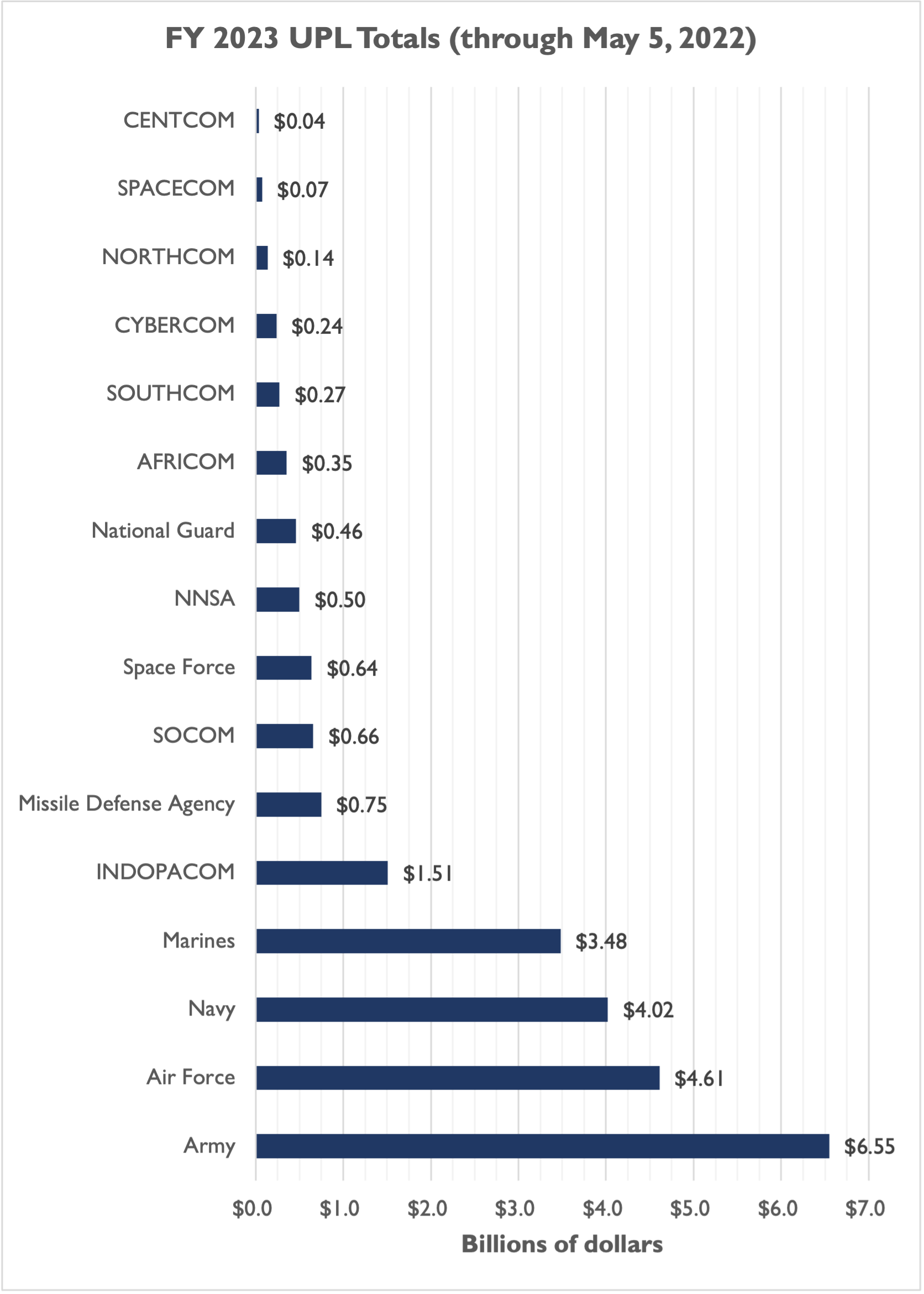The Senate and House have officially passed the fiscal year (FY) 2023 National Defense Authorization Act (NDAA). The legislation, which sets defense policy and authorized defense spending levels for the remaining nine months of FY 2023, now goes to President Biden’s desk for his signature.
While the NDAA is considered must-pass legislation in Congress each year as it helps ensure the troops are paid and the military has the resources that branch and command leaders say they need, recent NDAA bills have been characterized more by a callous disregard for massive taxpayer investments in the military than careful stewardship of over $800 billion in taxpayer funds.
Here are four ways taxpayers lost in the 2023 NDAA.
$80 Billion in Newly Authorized Spending, No Spending Offsets
Let’s start with the topline. Across all the programs and agencies that constitute the “050” budget function for national defense, Congress just approved $81.1 billion more for FY 2023 than they did for FY 2022. That’s a 10.26 percent increase, well beyond the 7.1 percent year-over-year increase to consumer inflation running through the economy as a whole.
In fact, the NDAA titles that contain spending items most subject to inflation – including food and fuel (under DoD’s operation and maintenance, or O&M, title), and pay for the troops (under DoD’s personnel title) – received smaller relative increases (9.16 percent for O&M, 3.07 percent for personnel) than spending on procurement for weapons, aircraft, and ships (11.07 percent increase) and research and development for longer-term projects (RDT&E; 17.95 percent increase). Military construction, which includes construction of family housing for the military, did receive a significant increase of 46 percent, in part due to increased housing and housing construction costs.


It may go without saying, but none of these massive authorized spending increases are paid for with reductions to other parts of the military budget. It’s $81 billion in newly authorized spending, which appropriators will almost certainly approve in their omnibus FY 2023 spending bill before the end of the year, and which will add to the nation’s debt and deficits in the long run.
More worrisome, overall authorized spending levels increased every step of the way from the completion of the FY 2022 NDAA last December to the completion of the FY 2023 NDAA this week, about a year later:
- FY 2022 authorized levels totaled $791 billion;
- The Biden FY 2023 budget request for defense was $827 billion, $36 billion more than FY 2022 levels;
- The House approved an $864 billion NDAA, $73 billion more than FY 2022 levels and $37 billion more than the Biden request;
- The Senate Armed Services Committee approved an $871 billion NDAA, $80 billion more than FY 2022 levels and $7 billion more than the House-approved NDAA; and
- Senate and House negotiators agreed to – and the Senate and House just passed – a final FY 2023 NDAA authorizing $872 billion, $81 billion more than FY 2022 levels and about half a billion dollars more than the Senate Armed Services NDAA.

Expect a repeat of this process next year for FY 2024 authorizations, unless Congress begins to exercise some real discipline with the military budget.
DoD “Wish Lists” Made Worse
Lawmakers must be in a festive mood ahead of the holidays, because the FY 2023 NDAA includes no efforts to pare back the growing collection of “wish lists” Congress requires from different components of the military each and every year.
These wish lists, formally called “unfunded priorities lists,” or UPLs, have been common practice among the military branches and combatant commands for decades, but in recent years Congress has required the branches, commands, and other Department of Defense (DoD) components to send lawmakers a UPL each and every year.
In the absence of the Overseas Contingency Operations (OCO) slush fund and the defense spending caps of the Budget Control Act era (which ran from 2012 through 2021), wish lists have been a leading cause of defense spending increases in recent years.
NTU closely tracked wish list requests this year, in partnership with the nonpartisan watchdog Taxpayers for Common Sense (TCS). We tallied wish list requests in excess of $24.3 billion for FY 2023, larger than the entire budgets of many federal agencies.

Fortunately, there is bipartisan, bicameral support for reining in these wish lists. Sen. Elizabeth Warren (D-MA) introduced legislation to repeal the statutory wish list requirements, and gained the support of independent Sen. Angus King (I-ME) and conservative Sens. Mike Braun (R-IN) and Mike Lee (R-UT). House companion legislation is being championed by progressive Rep. Pramila Jayapal (D-WA) and conservative Rep. Tom McClintock (R-CA).
Unfortunately, the FY 2023 NDAA not only excludes this bipartisan good-government reform, it actively makes the wish list process more entrenched and worse for the American taxpayer.
One provision included in the FY 2023 NDAA will require branch and command leaders submitting wish lists to assess how much “risk [will be] reduced in executing the National Defense Strategy (NDS).” As military hawks are fond of reminding lawmakers, an NDS Commission report “urged Congress to grow military spending by at least three to five percent each year” beyond the rate of inflation. Accordingly, tying the wish lists to the NDS and to subjective assessments of risk reduction are sure to push defense toplines even higher.
The same provision requires the Secretary of Defense and the Chairman of the Joint Chiefs of Staff to submit to Congress every year a ranked order of all unfunded priorities “according to risk reduced.” This will have the effect of getting the Secretary of Defense statutorily involved in the formation and dissemination of wish lists for the first time. It will make it more difficult for the current Secretary of Defense (and future Secretaries) to play a role similar to former Defense Secretary Robert Gates, who reduced the size and scope of these wasteful lists during the Obama administration.
No Consequences for Audit Failure
The Chief Financial Officers Act of 1990 required all federal agencies to complete annual financial audits for the first time. DoD took nearly thirty years to complete even their first audit, in FY 2018. They just finished their fifth annual audit, for FY 2022. DoD has failed all five audits.
As Breaking Defense reported recently, DoD was not even particularly close in having all its agencies achieve clean audits this year:
“Of the 27 military agencies audited, seven received a clean audit and one received a qualified opinion — a term used to describe an audit that will be clean after resolving a key issue. That’s ‘basically the same picture as last year,’ Pentagon Comptroller Mike McCord told reporters on Tuesday ahead of the audit’s release.”
For years, NTU has advocated for lawmakers to stop treating DoD with kid gloves and “carrots,” and instead start punishing the agency with “sticks” for ongoing failure to keep its financial house in order. We have supported bipartisan legislation from Sens. Bernie Sanders (I-VT), Chuck Grassley (R-IA), Ron Wyden (D-OR), and Mike Lee (R-UT) that would reduce a DoD component’s budget by the lesser of 0.5 percent or $100 million if they failed to pass their audit.
Unfortunately, lawmakers failed to include any audit “sticks” in the NDAA yet again.
Shoveling More Money in the F-35 Pit
The troubled, expensive F-35 fighter aircraft – which we have dubbed the $1.7 trillion plane that can’t fly – made headlines this week for all the wrong reasons. An F-35B, the Marine Corps’ version of the pricey jet, had a bizarre crash landing on a runway in Fort Worth, Texas. (Fortunately, the pilot of the plane is safe.)
The strange crash should be just the latest reason for Congress to pause new purchases of the plane. All that’s troubling the F-35 lately is 1) supply chain concerns such as for spare parts deliveries, 2) maintenance issues such as a lack of support equipment, 3) a malfunctioning and ineffective logistics software system that the military is currently in the process of completely replacing, and 4) underperforming engines, among other issues.
Instead of exercising restraint, Congress has ordered the purchase of 69 F-35 aircraft in FY 2023, eight more (or 13 percent more) than the military’s request to purchase 61.
More Responsibility Needed in FY 2024
Even as the calendar has yet to turn to 2023, lawmakers and military officials are already well underway thinking about what the FY 2024 defense authorization bill will look like. (FY 2023 ends on September 30, 2023; FY 2024 begins on October 1, 2023.)
NTU will call on Congress to think through both a right-sized and more responsible defense budget and a more honest and transparent defense budget process in the year to come.

